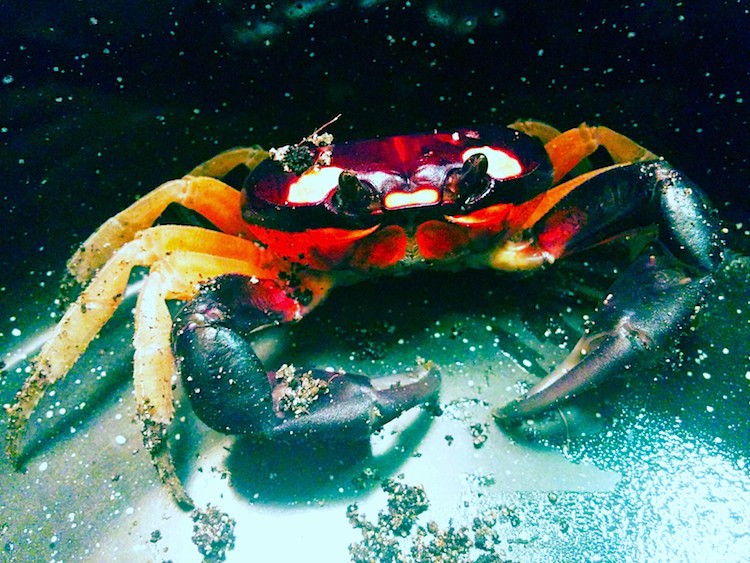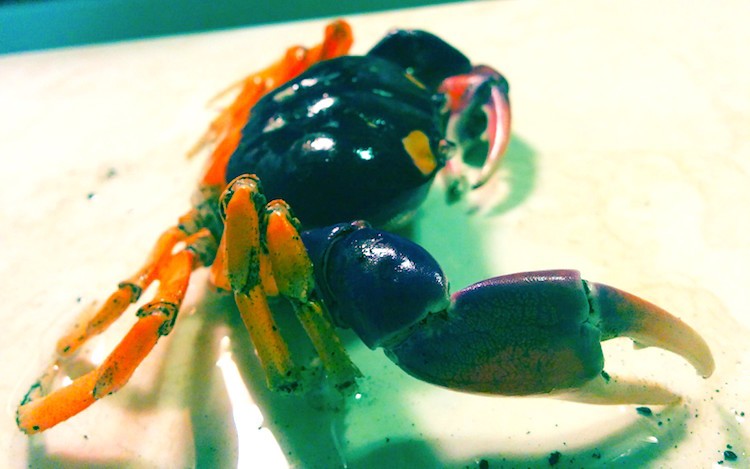
Part 1: What to Know Before Getting a Halloween Moon Crab
My introduction to the wondrous world of Halloween moon crabs was a complete surprise to me.
One evening a few years ago, 2 of my colleagues in the broadcasting and film industry showed up on my doorstep with a unique belated birthday gift: a 10-gallon tank with 3 of the most incredible-looking crabs I had ever seen. The colleagues had found them at a reptile store and told me they were called Halloween moon crabs.
Loving all living creatures, especially unknown ones, I was elated but hesitant. I didn’t have a clue how to feed or care for these curious, clacking critters.
Like so many pet store owners looking to make a sale, the guy at the reptile store had assured my friends that the crabs needed no special food, heat or substrate requirements other than newspaper, water and table scraps.
I was fascinated by these crazy-colorful crabs, who were approximately 10 times the size of my strawberry hermit crabs and had black bodies with brilliant orange legs, jack-o’-lantern white-rimmed, protruding eyes and dangerous-looking purple claws that they happily raised into a sparring position if any uninvited fingers intruded.
I hand-fed them some leftover roast beef, which they delicately placed into their tiny jaws via their pincers. I went to bed that night with wild dreams of decorating their cage the next day and naming them in my head.
I Was On My Own
The first order of business was to do some online research about my new family members to learn about their origins and care requirements.
But I found little information on how to care for these crabs in captivity other than the fact that they were land crabs with the scientific name Gecarcinus quadratus and were found mainly along the Pacific Coast in places like Mexico, Costa Rica and southward to Panama.
No luck at the bookstore, either. The only book in the World’s Largest Bookstore in Toronto was a thin How to Care for Land Hermit Crabs, with half a page at the back of the book dedicated to the Halloween moon crab that described them only in their natural habitat.
I found a few online posts from people in the United States who had tried and failed to raise them successfully in captivity. I was on my own with 3 new charges that I was determined to give the best life possible.

8 Things to Know About Halloween Moon Crabs
The following advice is what I’ve learned over the past 8 years through trial and error and a concerted effort to duplicate the crabs’ wild habitat as closely as possible.
1. Moon crabs like to fight each other.
They are difficult to sex, but within the first 2 years I unfortunately lost one of my crabs to an overnight brawl with a bigger crab, who I believe was a male.
2. A 10-gallon tank with newspaper substrate is unacceptable.
These crabs require enough space to burrow deep into the moist (but not damp) substrate to molt, which they do several times a year and shed their entire exoskeleton in 1 piece.
My 2 crabs Dante and Shiva happily reside in a 50-gallon fish tank with a handmade screen top for ventilation and to protect them from escape and injury.
They should be called “Houdini crabs” — they are agile climbers and can be found in the wild up tropical trees and in bushes.
3. Foster their natural climbing instinct by providing wood branches or faux foliage.
This will allow them to climb freely in their habitat. I recommend cork bark, which is readily available at most pet stores. It is light and retains water when you spray the enclosure to help create a humidified environment conducive to the crabs’ ability to molt.
Cork bark comes in a variety of shapes and sizes and can act as shelter for your crabs as well as a climbing medium. It’s moderately priced, long-lasting and will not rot like found wood gathered outside your home will.
Take a closer look at a beautiful Halloween moon crab:

You can also use half coconut shells for aboveground housing. The crabs will not try to eat plastic plants and will enjoy the scenery and climbing opportunities.
4. They can go as deep as 3 feet to create a network of underground burrows.
They do this for shelter and brumation close to a water source, usually on the banks of a river, ocean or estuary.
5. They are nocturnal.
Moon crabs hunt and forage at night, and they are buried or hiding during the day.
6. Moon crabs live on land but always near water.
They require access to both fresh and saltwater pools that are big enough to climb in and out of but not deep enough for them to drown — these crabs do not swim.
I use filtered or spring water to avoid the chemicals added to tap water. I refill it every other day in a 7-by-4-inch BPA-free Tupperware container with rocks and shells on the bottom to help the crabs get in and out safely.
Moon crabs must have access to fresh water at all times to moisten their gills.
7. They also need to have a smaller container filled with a teaspoon of raw sea salt diluted in hot water.
This provides them with the salt content for their diet that they require and would get in the wild.
8. Like most crustaceans, moon crabs require a regular source of calcium to fortify their exoskeleton (shell).
I have found that either placing a dish of Reptivite or similar powdered calcium brands mixed into their food is sufficient. But I like to keep a cuttlefish bone in their enclosure. They love to meticulously scrape off chunks with their pincers and ingest it.
In the next section of this Ultimate Guide to Caring for Halloween Crabs, I share what I’ve learned about substrate, temperature/lighting and what to feed them.

Part 2: How to Care for Halloween Moon Crabs
I’ve heard that the average life span of Halloween moon crabs in captivity can range from months (if proper care guidelines aren’t followed) to 5–6 years.
My 2 beauties are thriving at almost 8 years old since I received them, and there is no way to tell how old they were when I got them.
I’ve learned a lot during that time about caring for these animals. Below, I discuss substrate, temperature/lighting, what to feed them and how to handle these amazing pet crabs.
Substrate
I moisten the substrate with a 2-liter jug of water regularly so that it penetrates the deep layers right to the bottom and remains moist for burrowing and digging, but it should not be soggy.
My crabs have 1.5 feet of substrate in depth to explore, which I believe has contributed to their longevity. Keeping them simply on newspaper, as the reptile store owner suggested, would have quickly led to their demise.
The substrate recipe I have invented and used most successfully:
- It’s a mixture of condensed coconut husk fibers that comes in bricks at reptile stores and expands 4 times its size when soaked in water.
- To this I added organic black soil that has no chemicals or pesticides added, as well as calcium-fortified reptile sand.
- You can buy shells and bags of natural stones at the dollar store or a craft store to decorate the tank. This allows the crabs to roll them around and bury them to fortify the walls of their tunnels and underground dwellings. These crabs are intelligent and quite accomplished architects.
Temperature and Lighting
Temperature and proper lighting are important to this species, as Halloween moon crabs are generally found in tropical climates.
It’s essential that you use a reptile electric heating pad. Place it on the bottom or the side of your glass (not plastic) habitat.
Alternatively, you can use a reptile lamp stand with a minimum 100-watt bulb hanging over the aquarium’s screen on one side of the environment.
As far as thermometers, you can use a reptile thermometer inside the cage to ensure the temperature is 75–90 degrees Fahrenheit. Much like reptiles, Halloween moon crabs are cold-blooded animals and need to moderate their body temperature.

What to Feed Halloween Moon Crabs
I provide a smorgasbord of tempting morsels offered in a shallow food dish that closely replicates what they would scavenge for and eat in the wild.
Over the years, some of their favorite and nutritionally beneficial foods have included:
- Raw coconut (flesh and juices)
- Seeds
- Peanut butter
- Small pieces of fresh mango, pineapple or papaya
- Romaine lettuce and mixed salad greens
- An occasional sprinkling of commercial crab food
- Freeze-dried mealworms
- Fresh frozen and thawed crickets
- Scrambled eggs
- Sardines or plain uncooked, unspiced fresh fish
- Shrimps with the shell on
- Chicken
- Applesauce
Basically, any fresh fruit and vegetables I am making for myself, I set aside some for my omnivorous Halloween moon crabs.
Keep in mind that crabs have small stomachs, so large amounts of food left in their food bowl will tend to go moldy quickly and smell. It’s best to offer a variety of items each evening and replace their food the next day.
Watch this contented Halloween moon crab mosey around his aquarium:

Handling Halloween Moon Crabs
Try to handle your crabs as little as possible — it may stress them out, and their pincers are strong enough to penetrate a human finger.
I typically wear leather gloves to safely handle them and pick them up by the body from behind. Don’t pick them up by their pincers or legs — this could result in the loss of a limb.
Once every few weeks I allow them to run around my bathtub for additional space and exercise, and I place food items under fresh foliage to keep their wild instincts intact.
Halloween moon crabs, like other land crabs, are found in groups — so you shouldn’t keep them single. And it’s especially interesting to observe their behaviors and interactions at night.
One Final Word of Caution
My experience observing and interacting with these fascinating and beautiful creatures has been rewarding and enjoyable.
A word of caution if you’re considering Halloween moon crabs as your next pet: Make sure you have the finances, time and patience to provide a sizable habitat and the resources to maintain their requirements for healthy living.
This is not a good beginner pet for a novice crabber or a child.
That being said, among all the different crabs I’ve had or encountered in my life, these colorful characters possess a wide range of unique personality traits and communal behavior that make them a wonderful and precious addition to your family.


